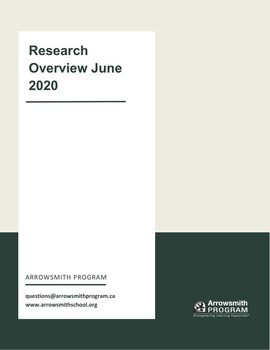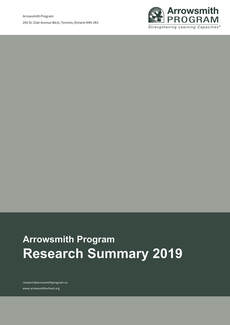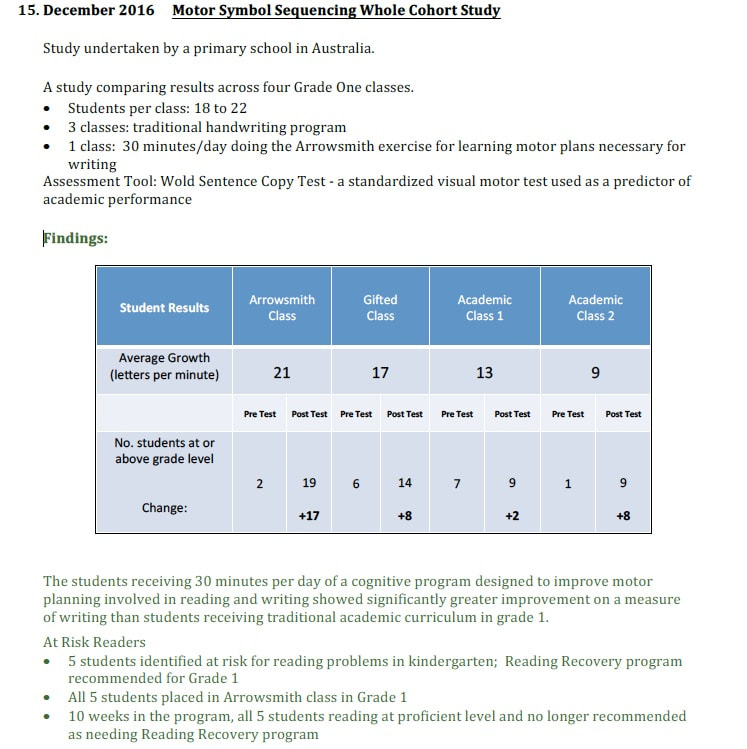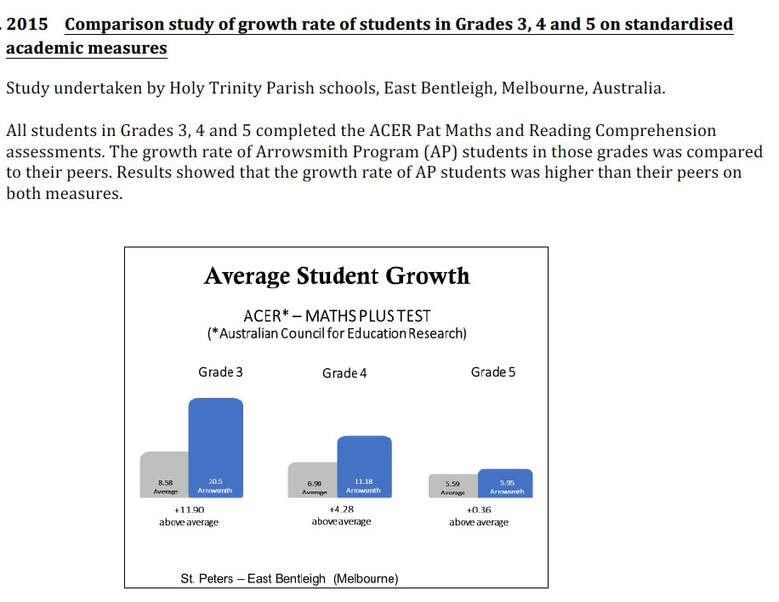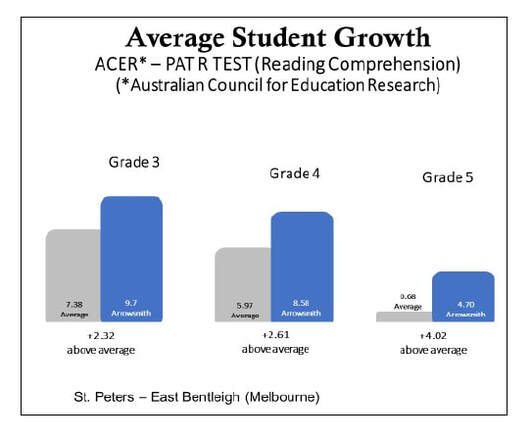|
.
|
|
Research Frequently Asked Questions
Click here to find the frequently asked questions about research on the Arrowsmith Program |
List of Research Studies and Reports
|
|
Synopsis
The study compared the performance of two groups of students, one working in either the Full-Time or Part-Time Program, and the other working in the Whole Cohort Program. Students were enrolled in classes at multiple Arrowsmith sites. It was concluded that while both groups made positive progress on the cognitive exercises. Research conducted in 2022 on the outcomes of the Symbol Relations Cognitive Program for school-aged students who have had significant negative impact on their cognition related to trauma, prenatal issues, childhood experiences and substance abuse. These students were enrolled in Teen Challenge Tasmania. Results demonstrated significant changes in a series of cognitive domains, academic skill domains and social well-being. Research conducted in collaboration with Teen Challenge QLD to determine if the Arrowsmith Symbol Relations Cognitive Program would benefit a group of individuals at Teen Challenge as they engaged in a treatment program for recovery from addiction. A comparison of the Cognitive Intensive Program student progress data from the In-person delivery mode (2019) and Online at-home delivery mode (2020) (2021) shows that there is no significant difference between the two delivery modes. Both delivery modes produced nearly identical results. These comparison results are based on masteries attained during the program and cognitive function assessment rating improvement from pre and post-assessment. Research conducted at Universidad Camilo Jose Cela, Spain on the outcomes related to engagement in the Arrowsmith Symbol Relations Program in typically developing students in an elementary school in Madrid, Spain was presented at the 32nd International Conference of Psychology, held in Prague. Results showed that students without learning disabilities significantly improved their visuospatial abilities over three months. Research conducted at Southern Illinois University and University of British Columbia on the outcomes of engagement in the Arrowsmith Symbol Relations Cognitive Intensive Program for students with learning disabilities was published in the journal, Applied Neuropsychology Child. Significant changes on a range of cognitive domains as measured on the Woodcock Johnson IV Tests of Cognitive Abilities were observed. The positive gains were measured on: Fluid Reasoning; Cognitive Processing Speed; Perceptual Speed; Cognitive Efficiency; Oral Vocabulary; Long Term Retrieval; Comprehension Knowledge; and Visual Auditory Learning. Research was presented at the 33rd American Psychological Society Conference on the impact of the Arrowsmith Cognitive Intensive Symbol Relations Program on cognitive functioning. Significant improvements were seen in the following cognitive domains as measured on the Woodcock-Johnson Cognitive Abilities Tests: cognitive processing speed; cognitive efficiency; perceptual speed; fluid reasoning; visual-auditory learning; and oral vocabulary. Research was presented at the 33rd American Psychological Society Conference on resting state connectivity changes in students engaged in the Arrowsmith Cognitive Intensive Program. Training on the Symbol Relations cognitive function in the Arrowsmith Cognitive Intensive Program strengthened resting state network connectivity. Connections in and between the Salience and Default Mode networks were particularly affected. The findings support the idea that enhancing resting state connectivity leads to improvement in task performance. Research conducted at the University of British Columbia (UBC) investigated the outcomes of the Brainex/Arrowsmith Program cognitive programs used by ABI Wellness in the treatment of individuals with chronic TBI. Following the pilot three-month cognitive intervention, there was a statistically significant increase in functional connectivity networks that had shown reduced connectivity in patients with TBI compared to healthy controls. The changes in cognitive scores in conjunction with the change in resting state connectivity give evidence of changes in brain-behaviour relationship following the intervention. The results from this pilot study provide preliminary evidence for functional network reorganization after cognitive rehabilitation in individuals with chronic TBI. Two studies were conducted by the Universidad Camilo Jose Cela, Madrid Spain. Students in an elementary school in grade one and grade three engaged in thirty minutes per day of the Symbol Relations/Reasoning cognitive program over 3 to 4 months. Significant cognitive changes were measured in Visual Spatial Ability; Attention; Planning Abilities/Executive Functioning; and Visual Spatial Numerical Ability Research conducted at the University of British Columbia (UBC) was presented at the International Neuropyschological Society Conference, Vienna. The study investigated outcomes of the 6-week cognitive intensive program addressing the Symbol Relations (Reasoning) cognitive function. Significant improvements were measured in: Fluid Reasoning; Cognitive Processing Speed; Perceptual Speed; Cognitive Efficiency; Oral Vocabulary; and Visual Auditory Learning. Research conducted at UBC was published in the journal learning: Research and Practice on students with learning disabilities enrolled in the Arrowsmith Program. This study evaluated the cognitive and academic growth of students who participated in one academic year of the Arrowsmith program. Participants demonstrated overall cognitive and academic growth as well as individual areas in which they improved after one year. Some areas of cognitive and academic growth were significantly correlated, suggesting a relationship in skill improvement. The results suggest that the Arrowsmith program may be associated with improvements in cognitive and academic skills. Research conducted at SIU was presented at the Society for Neuroscience Conference in Chicago. The study investigated outcomes of the 6-week cognitive intensive program addressing the Symbol Relations (Reasoning) cognitive function. Study undertaken by a school in Washington State offering the Symbol Relations Program as an elective to students in grades 6 to 11. The students received 90 minutes every other day of the cognitive exercise over 8 months. The students were assessed on standardized measures and a self-report questionnaire. Improvements were reported in mathematics, English and general learning capacities. Research conducted at UBC was presented at The 13th World Congress on Brain Injury, March 13 to 16, in Toronto. This research investigated ABI Wellness’ Four Pillar approach to neurorehabilitation for individuals with mild traumatic brain injury. The cognitive exercises used by ABI Wellness under the name of Brainex are the four higher-order cognitive exercises used in the Arrowsmith Program. The data demonstrated a decrease in functional connectivity in the right prefrontal region over the course of the 3-month intervention which was linked to behavioural changes and a reduction in both anxiety and depression. A study described in the poster, ‘Effect of comorbid learning and neurodevelopmental disorders on resting state functional and effective connectivity in adolescents’, was presented at the 2019 Cognitive Neuroscience Society Annual Conference in San Francisco, March 23-26, 2019. This research was conducted by Audreyana C. Jagger-Rickels, Ph.D., Gregory M. Rose, Ph.D., and Michelle Y. Kibby, Ph.D. of Southern Illinois University. Functional brain connectivity was investigated in two groups of students, typically developing (129 individuals, 13 to 19 years of age) and those in a school for students with complex learning disabilities (47 individuals, 13 to 19 years of age). For the typically developing students, within network connectivity decreased with age. The group with complex learning disabilities displayed both between network functional and effective hyper-connectivity. This hyper-connectivity suggests that the group with complex learning disabilities have less efficient networks, which could contribute to their learning disorder(s). A study described in the accompanying abstract, ‘Exploring the Relationship Between Improvement in an Intensive Learning Intervention and Changes in Resting-state Functional Connectivity’, was presented at the Sixth Biennial Conference on Brain Connectivity in Montreal, September 27, 2018, www.restingstate.com This research was conducted by Audreyana C. Jagger-Rickels, M.A. and Gregory M. Rose, Ph.D. of Southern Illinois University. They found resting-state connectivity changes in the brains of students engaged in the Arrowsmith Cognitive Intensive Program Brainex Symbol Relations exercise that were related to improvement in the task. Here is a brief description of the three networks identified. Salience NetworkFrontoparietal NetworkDefault Mode Network A 3-month pilot study, Changes in brain-behavior relationships following a 3-month pilot cognitive intervention program for adults with traumatic brain injury conducted at the University of British Columbia, found a statistically significant increase in the composite cognitive score in the TBI participants and a statistically significant decrease in functional connectivity in the right inferior frontal gyrus. In addition, there was evidence of changes in the brain-behavior relationships following the Arrowsmith intervention. The results from this pilot study provide preliminary evidence for functional network reorganization that parallels cognitive improvements after cognitive rehabilitation in individuals with chronic TBI. This Arrowsmith Program Research Summary Report provides an update on the studies on the Arrowsmith Program. These studies investigate changes in the brain as well as academic, cognitive, emotional, and social outcomes that occur for students engaged in the Arrowsmith Program. Study undertaken by a primary school in Australia offering the Whole Cohort Motor Symbol Sequencing Program to Grade One students.Findings: The students receiving 30 minutes per day of a cognitive program designed to improve motor planning involved in reading and writing showed significantly greater improvement on a measure of writing than students receiving traditional academic curriculum in grade 1. This Arrowsmith Program Research Initiatives Report provides an update on all ongoing studies on the Arrowsmith Program. Reports and other updates to the ongoing research will be released as they become available. These studies will investigate changes in the brain as well as academic, cognitive, emotional, and social outcomes that occur for students engaged in the Arrowsmith Program. The Arrowsmith Program summary document provides a high-level overview of both completed and ongoing research conducted on the Arrowsmith Program. This document groups the research studies into six categories: 1) Independent Research In Progress; 2) Completed Peer-Reviewed Research; 3) Completed Peer-Reviewed and Independent Research; 4) Completed Independent Research; 5) Other Completed Studies; and 6) Other Relevant Documents. A study undertaken by Holy Trinity Parish schools, East Bentleigh, Melbourne, Australia. All students in Grades 3, 4, and 5 completed the ACER Pat Maths and Reading Comprehension assessments. Findings: The growth rate of Arrowsmith Program (AP) students was higher than their peers on both measures. A study presented at a poster session at the American Psychological Convention, Washington, D.C. August 2014 by a research team at the Brain Gain Lab at the University of Calgary. Findings: following AP intervention improvements were found on the following cognitive domains: Auditory Processing; Fluid Reasoning; Processing Speed; Short-Term Memory; Phonemic Awareness; and Working Memory. A study presented at a poster session at the Canadian Psychological Convention, Vancouver June 2014 by a research team at the Brain Gain Lab at the University of Calgary. Findings: following AP intervention all academic scores improved and were in the average range except math fluency. Strengthening Cognitive neuropsychological functions presumed to underlie Academic achievement deficits improves reading, mathematics, and writing by targeting the cause (i.e., cognitive deficit) rather than the symptoms (i.e., achievement deficits). This first Research Initiatives Report summarizes five existing and ongoing studies of the Arrowsmith Program and its effects on the cognitive functions associated with specific learning difficulties, conducted at universities in Canada and U.S.A. These studies will show changes in the brain as well as academic, cognitive, emotional and social outcomes that occur for students engaged in the Arrowsmith Program. An independent re-analysis of data from a study in the Vancouver School Board undertaken by Dr. Linda Siegel, of elementary students identified as Learning Disabled (LD), one group in the Arrowsmith Program, and one group in an Extended Learning Assistance Class (ELAC). The focus of the ELAC group was on improving reading and writing skills. Findings: This re-analysis found only two significant results. On both the Comprehension and Spelling tests, the Arrowsmith group had significantly higher gains than the ELAC group (Comprehension; P= 0.002; Spelling: P= 0.012). Case Study research was conducted to investigate how participation in the Learning Disabilities Association of Saskatchewan (LDAS) Arrowsmith Program affected the cognitive, academic, emotional, and interpersonal functioning of five students who attended this program for two to three years. Findings: All of the students who participated in the research after participation in the Arrowsmith Program had significantly higher cognitive functioning/processing in at least one broad area measured by standardized tests and improved in some aspect of memory (working memory and/or long term retrieval). All four of the students who had returned to regular schools were taking academic programming at a higher level than they were previously. This report summarizes how the Arrowsmith Program cognitive exercises are directly and very specifically related to a wide range of learning difficulties. The report describes the relationship between the function of the cognitive areas for which the Arrowsmith Program has developed specific, targeted exercises, the learning difficulties if a student has a deficit in the cognitive area, and the learning outcomes achieved upon completion of the Arrowsmith Program exercises. There have been a number of studies that have demonstrated improvements in students’ academic skills upon completion of the Arrowsmith Program cognitive exercises. The increased cognitive capacities have enabled students to acquire a wide range of academic skills. All of the research has demonstrated a clear link between successful completion of the Arrowsmith Program cognitive exercises and improvements in basic academic skills. This report contains a summary of these research studies, as well as providing examples of the correlation between the Arrowsmith cognitive exercises and Reading, Writing, Spelling, and Mathematics. Of particular interest to educators, parents, and students are the significant gains demonstrated by students after completion of the Arrowsmith Program of their scores on standardized psycho-educational assessments. A follow-up study tracking the progress of students in the Arrowsmith Program in the TCDSB on standardized achievement measures and on the amount of resource support needed pre and post-Arrowsmith Program. Reports from parents, teachers, and students of specific observable cognitive and academic gains and on the success of TCDSB Arrowsmith students in high school and post-secondary programs. A three-year outcome study of 79 children with learning disabilities conducted at Arrowsmith School funded by the Canadian Donner Foundation. A number of standardized measures were used such as achievement tests and tests of mental ability as well as measures of learning capacity and changes in rates of learning. Study undertaken by Dr. William J. Lancee, Ph.D. Head of Research in the Department of Psychiatry at Mount Sinai Hospital and Associate Professor, Department of Psychiatry, University of Toronto. Study undertaken by Dr. Linda Siegel, Professor of Educational and Counselling Psychology and Special Education at the University of British Columbia. Ten students were selected by the Vancouver School Board (VSB) at an Elementary School for the Arrowsmith Program experimental group and a comparison group of seven students in an Extended Learning Assistance Class (ELAC) in the VSB. The focus of the ELAC group was on improving reading and writing skills. Study undertaken by The Special Education Advisory Committee of the Toronto Catholic District School Board. The Program review included the Arrowsmith Program, the Hospital for Sick Children Learning Disabilities Research Program, self-contained special education classroom, and resource/withdrawal or integration in the regular class with modifications and/or accommodations. A one-year study comparing outcome measures of 30 grade 2 to grade 7 students enrolled in the Arrowsmith Program from 4 schools in the Toronto Catholic District School Board (TCDSB) to 10 students in a traditional special education classroom for students with learning disabilities. Study undertaken by Dr. William J. Lancee, Ph.D. This research paper investigated the relationship between a program designed to train automatic written motor symbol sequences for a group of 12 learning disabled individuals having difficulty with the writing process and outcome measures on a test developed to measure the rate of learning a repeated sequence of symbols as an automatic motor pattern and standardized tests of writing and copying. Significant positive changes were found from pre- to post-treatment testing on all measures. A three-month study comparing 15 students in the Arrowsmith Program within the TCDSB to a group of TCDSB students using Autoskill’s Academy of Reading Program Changes on Standardized Cognitive Measures of students in the Arrowsmith Program observed at Eaton Arrowsmith School or by Eaton Learning Centre A pilot project undertaken in co-operation with St. Patrick Catholic Secondary School in the Toronto Catholic District School Board. The report summarizes the averaged quantitative improvements seen in 19 students working on 4 cognitive areas over a 7 month period. This research paper investigated the relationship between a test developed to measure the rate of learning a repeated sequence of symbols as an automatic motor pattern and standardized tests of writing and copying. Performance on the motor symbol sequencing test, for a group of 12 learning disabled individuals and a control group of 35 adults, correlated significantly with standardized tests of copying and handwriting. |
The Arrowsmith Program is backed by research.
Take the next Step
|
Is Arrowsmith right for me
Vertical Divider
Talk to
Admissions |
What we offer
Vertical Divider
Check out our
Programs |
How to Enrol
Steps to
Enrolment |

